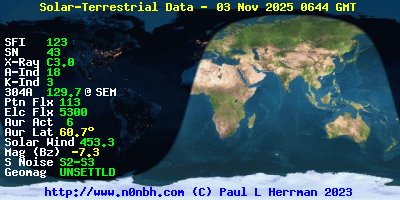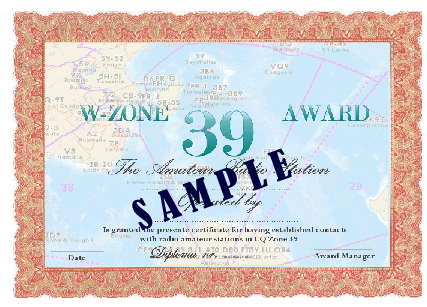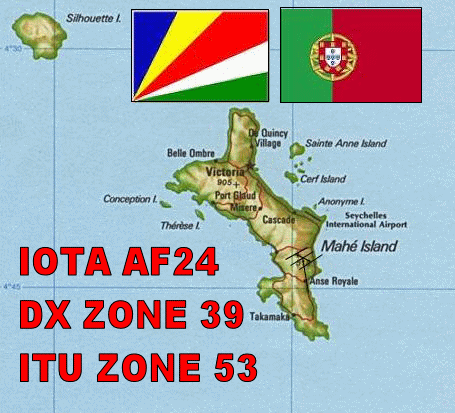|
Propagation
Prediction on-line

Table
Frequencies:
I will almost always
operating “split”, in other words listening a few kHz away from
where we are transmitting so everyone can still hear me no matter
how many callers are calling. I will occasionally tell
you exactly where to transmit by saying something specific like
“listening up five” or “listening two-fifty“ but most of the
time we will just say “up” or “down” (“dn” on CW) as a
clue to where you should tune your TX.
PS We sometimes
make mistakes too and shift the wrong VFO - sorry, we’re only
human.
By maintaining a
consistent rhythm, i hope to avoid encouraging other callers to call
while a QSO is still in progress. I will simply ignore
tail-enders and, if they are really rude, we may blacklist blind
callers, at least for a while. If i hear someone we have just worked
immediately calling again, i will repeat their call and say
something like “QSL” or “You’re in the log” to confirm and
complete the QSO. If i made a mistake in the log, we will
correct it and confirm on air. We may just ignore callers
making duplicate calls on different occa
I will also be
listening more than I transmit. We will use our filters etc.
to the best effect and will make a special effort to pick out weak
callers, whether DX or QRPers or Mobiles (ideally both!)
We may repeat just a
few characters of a call if we cannot resolve the complete call.
This means we are listening to someone specific and will persist
until we get the complete call. If we made a genuine mistake
and nobody returns to our first or second offer, we will say
something like “No copy, QRZ” or “NIL” on CW but please be
patient until that point.
MHZ
/ Typical Operating Frequencies
-
Let
us know your necessities about Bands and Modes. send us your request
Will
try to give you more than one band and mode.
See
you during our
Adventure
-
Please
kindly if you ear or work us, spot on the cluster to others.
I will look out especially for well modulated signals, even the
weak ones, and will make sure our own signal is clean.
-
We
give special attention to QRPs , SWL , NOVICE and Mobile Stations
-
Please
NO DUPES QSO's , give the chance to others! If you work us
already, please don't call again at least on different mode.
-
If
propagation opens up for DX QSOs, I may start calling specific
areas or continents but only for a while, Ie promise.
I'm conscient of the short greyline openings to North
America and Asia, and will be looking for long path as well
as short path openings when the time is right. If I work
some juicy DX in a run of ordinary QSOs, I may put the pileup on
hold and call for more DX to take advantage of the opportunity.
Be patient with me: I like working DX too!
-
| BAND |
MODE
|
FREQUENCY
MHz |
|
80
|
CW |
3.507
and 3.527 |
|
40
|
CW |
7.050
and 7055 |
|
40
|
SSB |
7.060
(listen above 7.200 for NA) |
|
30
|
CW |
10.117
and 10.119 |
|
30
|
RTTY |
10.137 |
|
20
|
CW |
14.006
and 14.054 |
|
20
|
SSB |
14.145
and 14.260 |
|
20
|
RTTY |
14.080 |
|
17
|
CW |
18.084 |
|
17
|
SSB |
18.140 |
|
15
|
CW |
21.021
and 21.054 |
|
15
|
RTTY |
21.080 |
|
15
|
SSB |
21.260 |
|
12
|
CW |
24.897 |
|
12
|
SSB |
24.977 |
|
10
|
CW |
28.007
and 28.027 |
|
10
|
SSB |
28.477 |
Worked Zone 39
Award:

To qualify for ZONE 39 AWARD,
the following conditions must be satisfied:
1.
Establishment of
two-way communication with any
10 (ten) different
amateur stations located in Zone 39 at least on 5 DXCC Entities
Only contacts made after 0800 UTC on
1st January 1952 are valid. DXCC Entities: D6-Comoros, FH-Mayotte, FR-Reunion, FR/G-Glorioso,FR/J
Juan de Nova, FR/E-Europe Island, FR/T Tromelin, FT/W-Crozet Island,
FT5/X-Kerguelen Island, FT5/Z Amsterdam & St. Paul Island,
3B7-Seychelles, VKØH-Heard
Is., VQ9- Chagos, 3B6-Agalega & 3B7-St.Brandon Island, 3B8-Mautitius
Island, 3B9-Rodriguez Island, 5R-Madagascar and some Antarctic
Zones. (The boundaries of CQ zones 12, 13, 29, 30, 32, 38
and 39 converge at the South Pole. Stations KC4AAA and KC4USN are at
the South Pole, and will count for any one of the listed zones. Most
Antarctic stations indicate their zone on the QSL card.)
2. The total of 10 different stations may be obtained
by operation
on one or more of the authorised
amateur bands,
as applicable at the time of the
claimed contact.
Cross-band contacts will not be
accepted.
3. Any type of emission as permitted by the local
licensing authorities
at the time of the claimed contact may
be used.
Cross-mode contacts will not be
accepted.
5. Applications containing multi-band and multi-mode
valid contacts
will be accepted but the award will be
issued with no endorsement.
6. Short Wave Listener applications will be accepted
and the Award certificate issued,
with appropriate endorsements as
applicable,
when all conditions listed above are
complied with.
7. QSL cards are not required as proof of valid
contacts
but the application must show that log
extracts have been examined
and verified by two other radio
amateurs or the
Awards Manager of the applicants IARU
affiliated radio society.
A simple declaration that the applicants station has
conformed
to all licensing regulations as related
to his operation is mandatory.
8. The fee for the Award shall
be 5 Euros or 6 USD or 4
IRCs for overseas stations.
10. Essential
information required will include:
|
Callsign Worked/Heard
|
Date/Time (UTC)
|
Band/MHz
|
Mode
|
11. The Award Manager
is: Manuel Alberto C. Marques
P.O.Box 41
2780-901
OEIRAS
PORTUGAL (Europe) |


